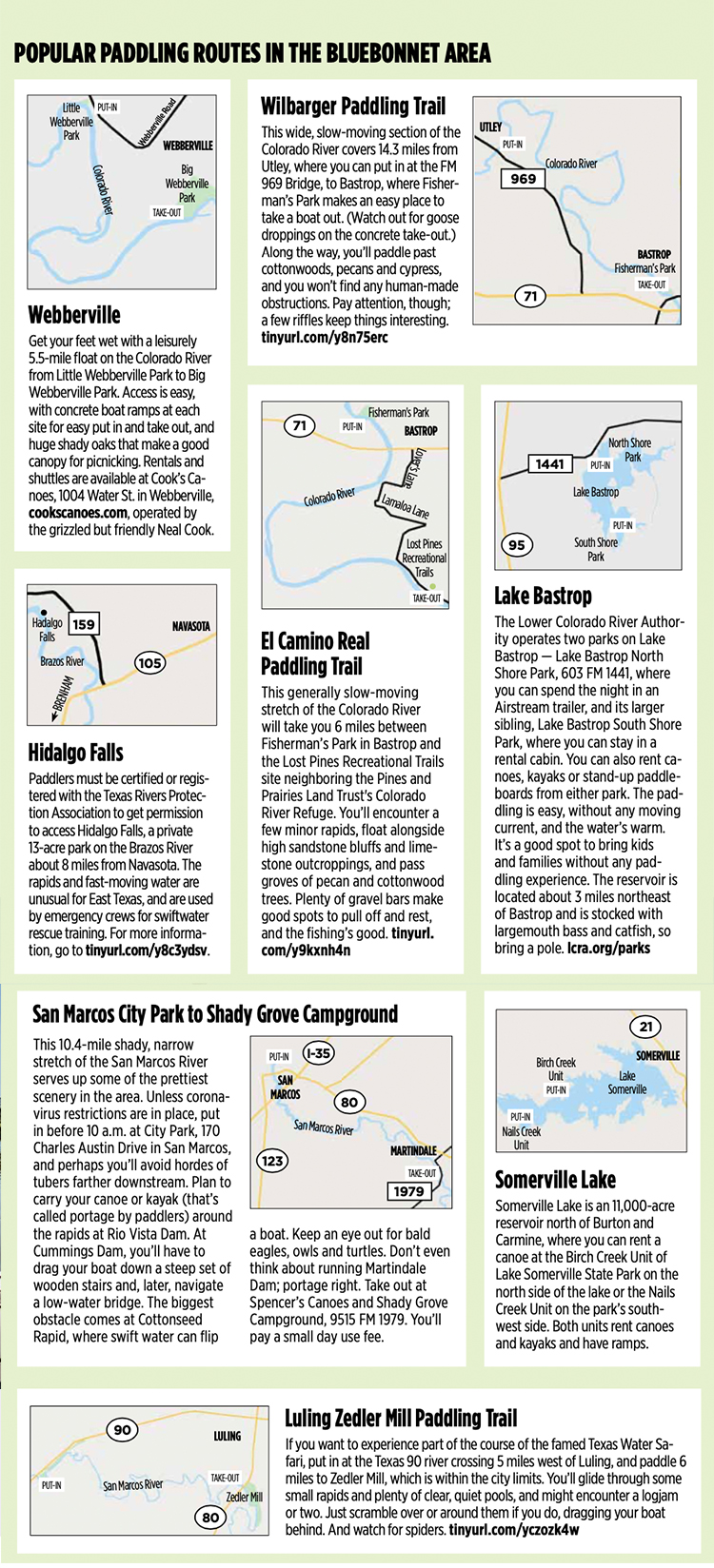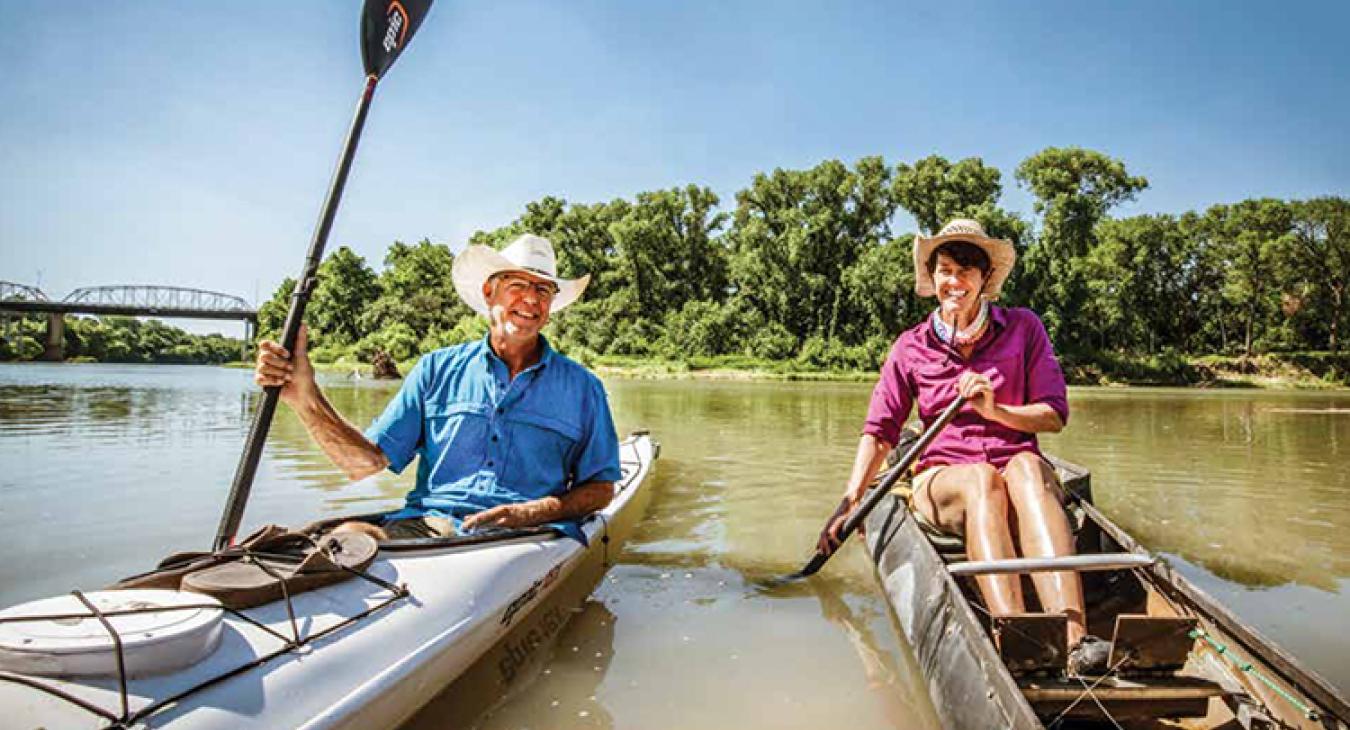Pam LeBlanc and Jimmy Harvey paddle their boats on the Colorado River at Fisherman’s Park in Bastrop. (Sarah Beal photo)
GET GOING - With Pam Leblanc
One in a series of stories on fitness, recreation and outdoor adventure in the Bluebonnet Electric Cooperative region.
Midway through a 25-mile paddle down the Colorado River, Jimmy Harvey pulls his kayak beneath a canopy of trees along the bank and waves me over. I glide up alongside him, un- sure what to expect. “Put your paddle down,” he says. The quiet settles around us like a blanket. “Listen. No human noises. Just the wind, the river and the birds.”
He’s right. We can’t hear the buzz of traffic or the drone of an airplane or even the sputter of a lawn mower down here between the banks. It’s perfectly blissful.
We packed water and snacks, plus a spare paddle, a GPS and a cell phone in case of emergency, and shoved off from Fisherman’s Park in Bastrop at 8:30 this morning, our boats pointed toward Smithville. The river twists and turns like a length of rope here, but it all feels miles away from civilization. By the time we ease our boats beneath the highway overpass in Smithville four and a half hours later, my back is tired and my rear end feels half-frozen in place, but I’m happy.
Harvey is a longtime paddler who first canoed as a kid on the Devil’s River in West Texas. The Austin resident has completed numerous endurance canoe races, including the Texas Water Safari, a 260-mile nonstop race from San Marcos to Seadrift on the Texas coast.
I’m relatively new to paddling, but in 2019 I joined two other women, both veteran paddlers, to race the Texas Water Safari. We faced logjams, mud, palm-sized spiders, hallucinations and human-sized alligator gar in that adventure.
But this day’s Colorado River paddle reveals a completely different and much more relaxed side of the sport.
Before dragging our boats ashore, we’ve spotted blue herons, soft-shelled turtles, cattle and what almost certainly was a bald eagle, flapping away from the towering skeleton of a dead cottonwood tree. While leaving a small gravel bar where we took a break, I nearly paddled over a short, thick snake that looked like a water moccasin while steering my boat back into the current.
This is why I love to paddle in the first place — to get an up-close look at wildlife on the river while following an unspooling highway of liquid wherever it goes, at a pace that just feels natural.
I’m grateful for the previous day’s rain, which delivered a nice flow to help propel us. I’m also thankful for Harvey’s expert eye, and I try to glean a little of his skill as we go. Where I see a uniform swath of water, he can read riffles and swirls, and knows exactly where to position his boat to get the best ride. Paddling traces its American roots to the northern states, where Native Americans and fur traders used canoes for transportation. It remains popular in the northern U.S. and Canada, for both recreation and competition. But Texas enjoys one big advantage — a mild climate.
“You can paddle here in the winter. Up north, the streams are frozen,” says Bob Spain, author of “Bob Spain’s Canoeing Guide and Favorite Texas Paddling Trails.”
Spain got into canoeing because he liked the adventure. “I’ve paddled in 40 or so states, raced in 25, and met people all over the country and abroad,” he says. “When you canoe, you see things you wouldn’t see otherwise.”
Just about anyone can do it, too. Most start with a kayak, because it’s easier to steer. But canoeing offers its own set of advantages: You won’t get as wet while doing it, and you can load a canoe with enough gear for a paddle camping trip. Either way, a day on the river is a day well spent.
“It’s something you can do your whole life, and you don’t have to be a pro or in great shape,” Spain says. “If you want to float down river and throw a hook in, you can do that. You get what you put into it.”
Here in Central Texas, the Colorado River serves up a smooth ribbon of water that includes several stretches designated by the Texas Parks and Wildlife Department as paddling trails. If you go, remember it’s OK to stop on gravel bars or islands in the river, but respect private property. Rainfall upstream can create high flows downstream, so check flow levels before you go. Area lakes make good paddling grounds, too.
In and near Bluebonnet’s southwestern service area, San Marcos and nearby Martindale offer opportunities to access the San Marcos River, which flows into the Guadalupe River downstream. The river serves up some of the prettiest paddling in Central Texas, with cypress-lined stretches of cool, green water and a few rapids capable of bucking inexperienced paddlers.
For information about current river conditions, go to www.lcra.org or https://on.doi.gov/2VNVxUH.
There are several spots in the Bluebonnet region where you can put in a kayak or canoe for a long, leisurely (or in some spots more challenging) float. You must make pre-planned take-out arrangements for the end of your trip. Check with state parks or the paddling site owners for restrictions on access, required face coverings and social distancing requirements due to COVID-19.
Pam LeBlanc has written about fitness, adventure and recreation in Central Texas for decades. Her work has appeared in Texas Monthly, Texas Highways, Texas Parks & Wildlife and Real Simple magazines, and the Austin American-Statesman.
HELPFUL RESOURCES FOR PADDLING PLANNING
The Texas Parks and Wildlife Department has a guide to all of the good boating/paddling routes around the state, along with a calendar of paddling events and information on how to paddle, equipment, education and laws. tinyurl.com/ydbjja7h
LCRA Colorado River Guide for Paddlers is an interactive guide for access points and navigation features along the lower Colorado River. This web page also provides other resource information and contact information for LCRA parks. tinyurl.com/yc65lqo2
Texasoutside.com’s list of the state’s kayak and canoe paddling trails mentions several in the Bluebonnet region and around the state. tinyurl.com/yctuusxv
PADDLING OUTFITTERS
Availability may be impacted by coronavirus restrictions. Call before you make plans.
BASTROP RIVER COMPANY
Fisherman’s Park 1400 Willow St., Bastrop 512-321-4661 bastropriverco.com
Canoe, kayak and stand-up paddleboard rentals by the hour or river trip, and shuttle service
RISING PHOENIX ADVENTURES
1409 Chestnut St., Bastrop 512-677-2305 risingphoenixadventures.com
Canoe, kayak and stand-up paddleboard rentals and shuttle service on the Colorado River from Austin to La Grange
COOK’S CANOES
1004 Water St., Webberville 512-276-7767 cookscanoes.com
Canoe and kayak rentals
TG CANOES & KAYAKS
402 Pecan Park Drive, San Marcos 512-353-3946 tgcanoe.com
Big selection of boats, equipment to buy; will make repairs but no rentals or lessons
TEXAS CANOES & KAYAKS and PADDLE WITH STYLE
Reservations at P.O. Box 512, Martindale, 78655 512-749-2350 texascanoekayak.com paddlewithstyle.com
Lessons for all ages, experience levels; boat rentals, guided trips
SAN MARCOS RIVER RETREAT
444 Pecan Park Drive, San Marcos 512-392-6171 sanmarcosriverretreat.com
Shady campground serves mainly youth groups, emphasis on learning to canoe/kayak

Download this story as it appeared in the Texas Co-op Power magazine »





